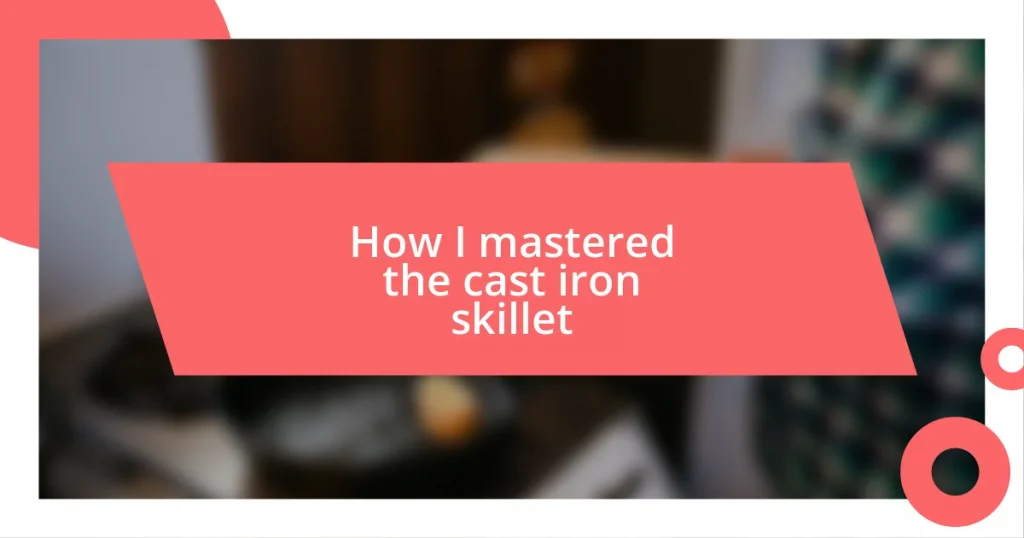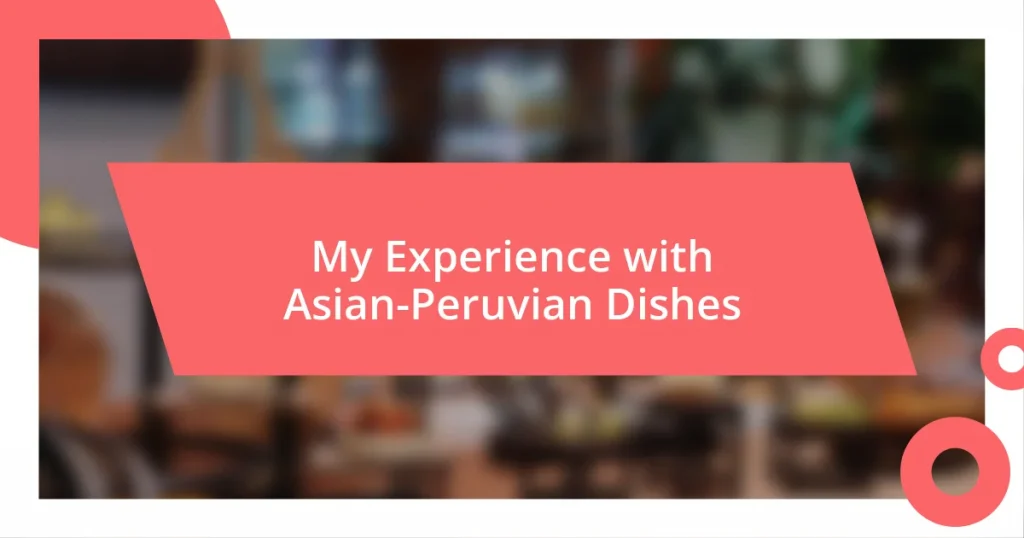Key takeaways:
- Seasoning your cast iron skillet is essential for creating a non-stick surface and enhancing its longevity, requiring attention and care over time.
- Choosing the right skillet involves considering size, weight, pre-seasoning, and brand reputation to ensure a versatile and durable cooking tool.
- Cooking techniques, like proper preheating and using a mix of oils, unlock the skillet’s potential for flavor and versatility, allowing for various dishes from seared meats to baked goods.
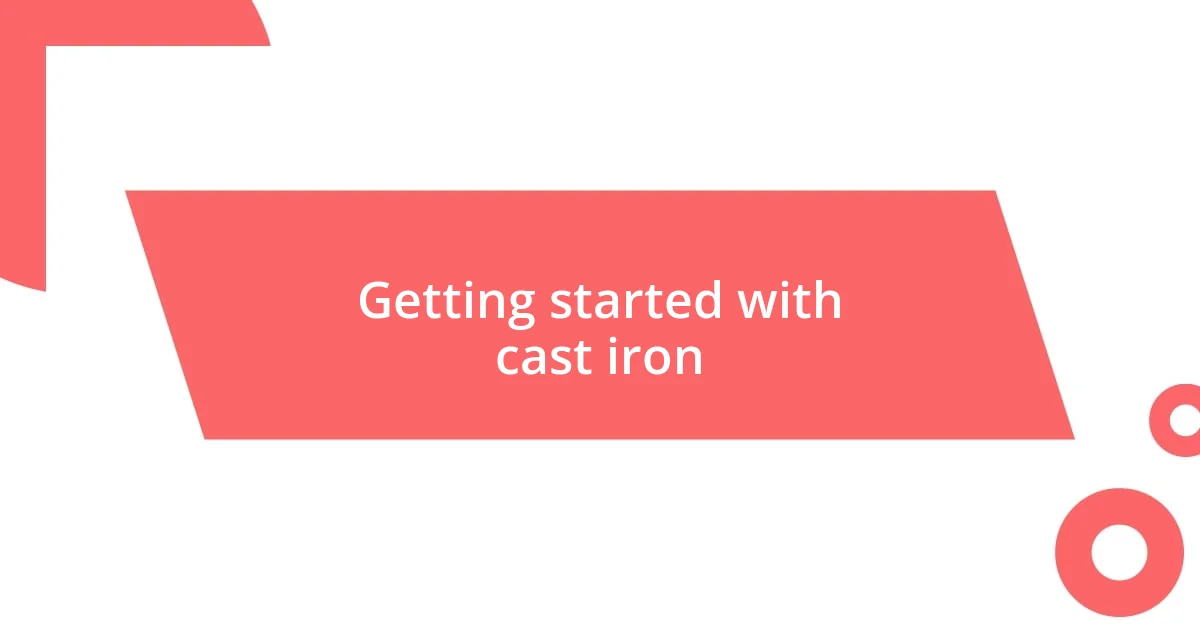
Getting started with cast iron
When I first picked up my cast iron skillet, I was both excited and intimidated. I remember thinking, “What if I ruin it before I even know how to use it?” But as I began my cooking journey, I realized that this skillet was more than just a pan—it was a culinary tool that could elevate my dishes in ways I never expected. The moment I cooked my first steak in it, and the beautiful crust it developed made me feel like a kitchen magician.
Getting started with cast iron isn’t just about choosing the right pan; it’s about understanding its care and use. Early on, I learned that seasoning my skillet was not just a chore—it was a bonding experience. I vividly recall the first time I seasoned my skillet, carefully applying oil and watching the surface transform. There’s a unique satisfaction in maintaining a cast iron piece, knowing that each use and care session adds character to my trusty tool.
Have you ever felt that connection with your kitchenware? For me, the more I cooked with my cast iron, the more I respected its quirks; from the way it retains heat to its slightly uneven cooking surface. Embracing this pan’s imperfections taught me that great cooking often comes from adapting and learning—wonderful lessons that extend far beyond the kitchen.
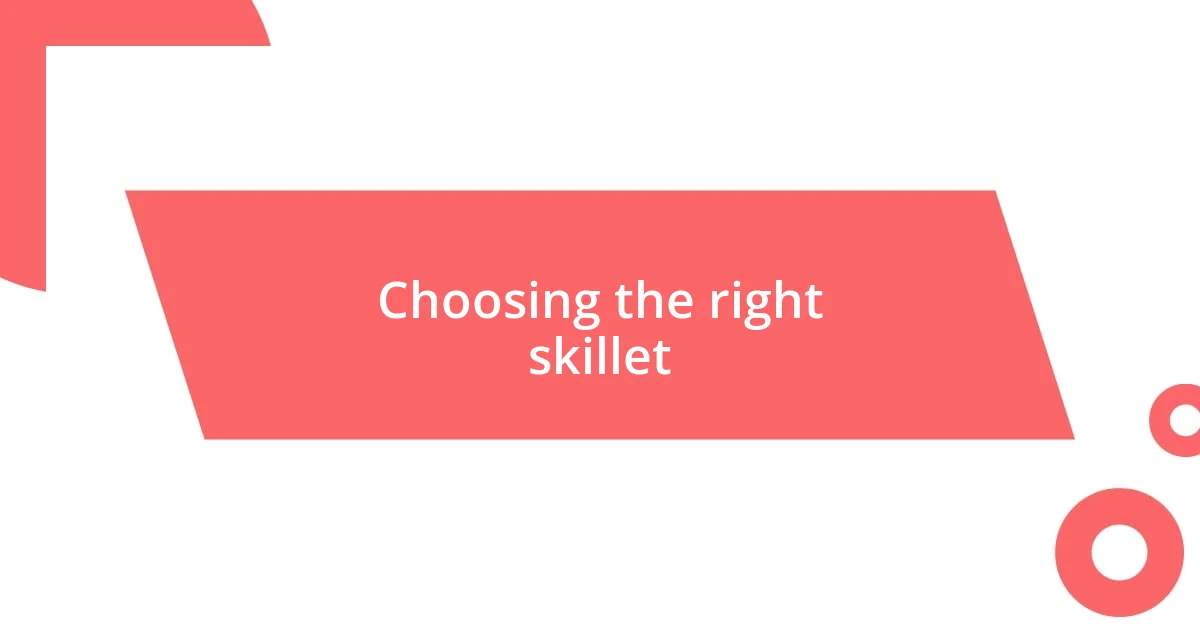
Choosing the right skillet
Choosing the right skillet can feel like a monumental task, especially when you’re faced with so many options. In my experience, it starts with understanding what you plan to cook most often. I remember standing in the kitchen aisle, weighing the pros and cons of various sizes and weights. A lighter skillet may be easier to handle, but I found that a heavier one distributes heat evenly, creating that perfect sear I love.
When selecting a cast iron skillet, consider:
- Size: Think about the number of people you usually cook for. A 10-12 inch skillet is versatile for most meals.
- Weight: A heavier skillet retains heat better, but if you’re not comfortable lifting it, find a balance that works for you.
- Pre-seasoning: Some skillets come pre-seasoned, making it easier to start cooking right away. If not, be prepared to season it yourself.
- Handles: Look for a skillet with a sturdy handle that feels comfortable when you lift it.
- Brand reputation: Opt for brands known for quality cast iron. Trust me; a well-made skillet can last a lifetime.
As I navigated these decisions, I found that my skillet became more than just a cooking tool—it turned into a reliable companion that I felt a deep connection with over time. Each meal prepared with it brought new memories, whether it was the first cornbread I baked or the tender roast I perfected on a special occasion.
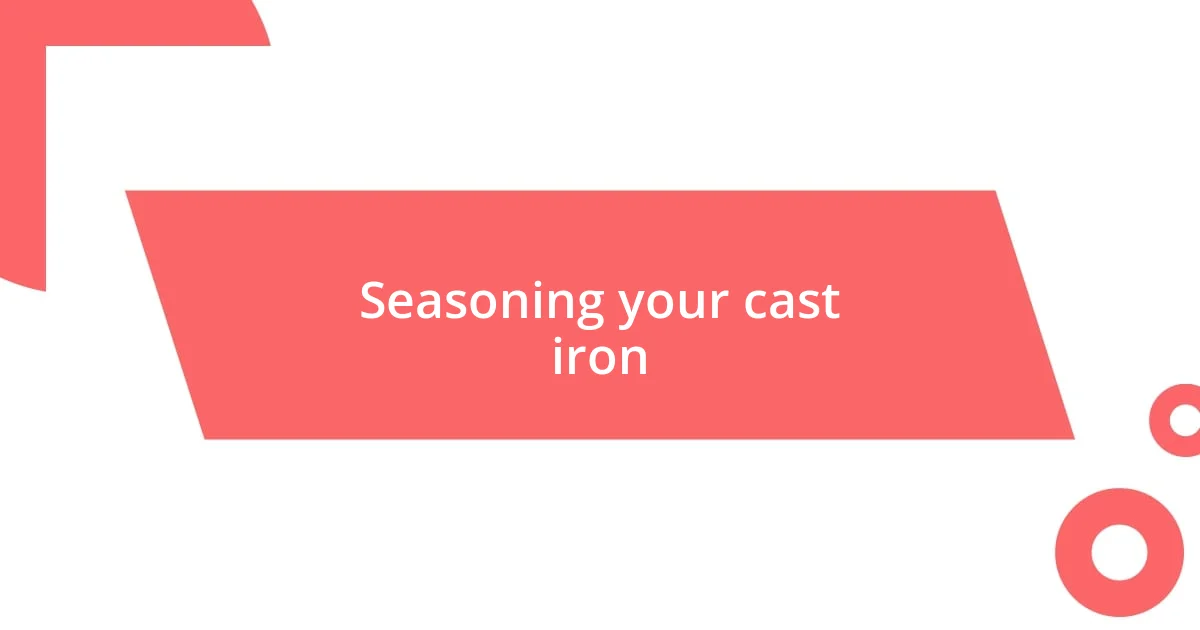
Seasoning your cast iron
Seasoning your cast iron skillet is a crucial step that enhances its performance and longevity. In my early days of cooking, I was surprised to learn that seasoning is not just about creating a non-stick surface; it’s about developing a natural patina that strengthens the skillet over time. I remember the first time I seasoned my skillet—I took my time, heating it slowly, and it felt almost meditative. It was exhilarating to see the oil gradually darken and build up that wonderful layer of protection.
I often compare seasoning a cast iron skillet to nurturing a garden. Initially, the skillet requires attention and care, but with diligence, it flourishes and becomes more resilient with every use. Repeatedly cooking with fats, like bacon or olive oil, aids in building that coveted layer, making each meal a learning experience. I couldn’t believe how something as simple as frying an egg could lead to such a fine finish; as my skills grew, so did my skillet’s seasoning, and I felt a deep sense of accomplishment every time I used it.
It’s fascinating how the world of seasoning can feel a bit daunting but also enthralling. Each time I added a new layer, it felt like I was honoring the skillet’s history and my own cooking journey. Have you ever had that moment of pride when seeing a perfectly seasoned pan? It’s more than a cooking tool; it becomes a participant in your culinary adventures, absorbing flavors and stories that make each meal special.
| Seasoning Methods | Details |
|---|---|
| Initial Seasoning | Apply a thin layer of oil to a clean skillet and bake upside down for an hour at 350°F. |
| Re-seasoning | After heavy use or rust, scrub the skillet, dry thoroughly, and repeat the initial seasoning process. |
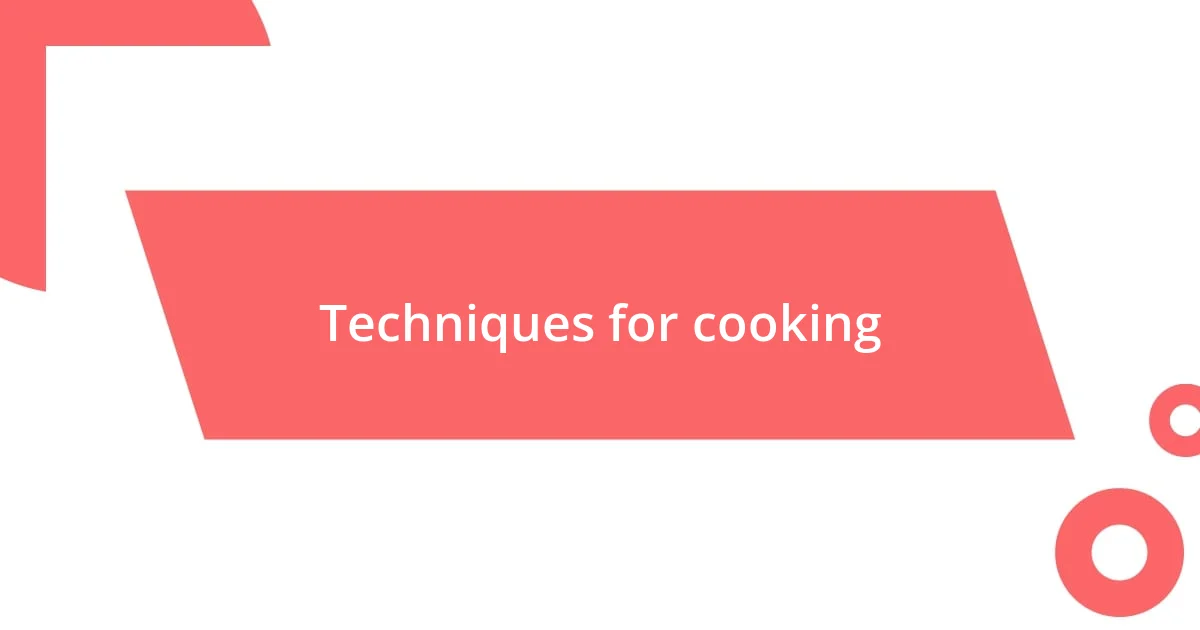
Techniques for cooking
Cooking with a cast iron skillet unlocks a world of flavor and technique that I truly cherish. One of my go-to methods is preheating the skillet before adding food. Picture this: I remember the first time I threw a steak onto a hot surface—what a delightful sizzle! It was the sound of anticipation, and that initial heat sears the meat beautifully, sealing in all those juicy flavors. If you’re wondering how to get the best results, I always recommend heating your skillet over medium-high heat for a few minutes before cooking. This little trick has transformed my approach to searing meats and even sautéing vegetables.
Another technique I’ve embraced is using a combination of oils. I used to think olive oil was the be-all and end-all, but I quickly learned that blending oils can elevate your cooking. For instance, I often mix olive oil with a splash of vegetable oil when frying, which raises the smoke point and adds a richer flavor profile. Isn’t it amazing how simple adjustments can make such a significant difference on your plate?
Lastly, I love the versatility of a cast iron skillet when it comes to cooking methods. Whether I’m baking a cornbread or making a frittata, I’ve discovered the joy of transferring my skillet from the stovetop to the oven. I vividly recall the first time I baked a cake in one—it felt like a bold step into uncharted territory. That cake turned out spectacularly fluffy, and it felt rewarding to serve it straight from the skillet, a rustic touch that always impresses guests. Have you experienced that seamless transition between cooking methods? It not only showcases the skillet’s capabilities but also makes meal prep feel more intuitive and creative.
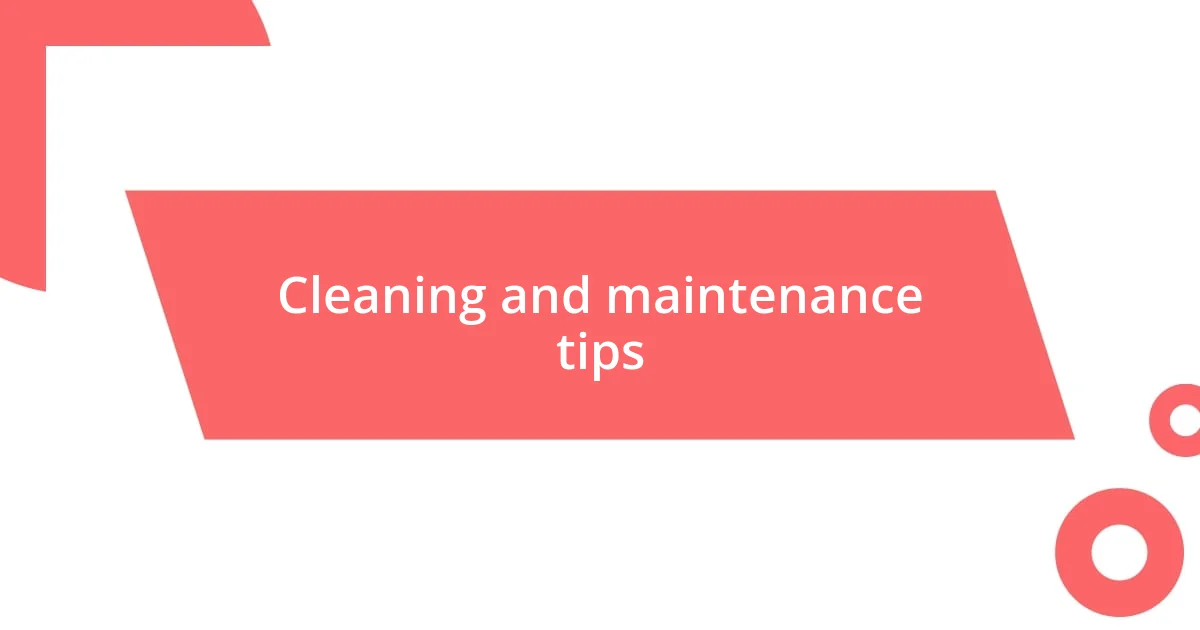
Cleaning and maintenance tips
Cleaning your cast iron skillet is a bit of an art form that I’ve perfected over time. After every use, I prefer to rinse it with warm water and use a stiff brush to remove any stuck-on food. I remember when I first started—I used soap out of habit, thinking it was necessary. It took a few ruined meals until I realized that soap can strip away the cherished seasoning I worked so hard to build. Now, I simply wipe it down with a cloth and let it air dry, which I find helps maintain that precious seasoning.
If you ever encounter rust, don’t panic; I’ve been there too! A simple scrub with a mixture of coarse salt and water can work wonders. I once had a near-disaster where my skillet developed rust after I neglected it during a busy season. I was determined not to part with it, so I grabbed the salt and scrubbed away, feeling the layers of history beneath my fingers. It was both frustrating and rewarding; seeing it return to its former glory reminded me of the skillet’s resilience—and mine too!
For maintenance, I also regularly apply a thin layer of oil after cleaning. I’ve found that using flaxseed oil not only treats the surface but also enhances the skillet’s seasoning. Each time I finish this task, there’s a satisfying sense of completion, almost like putting my skillet to bed, ready for the next culinary adventure. Have you developed a routine for keeping your skillet in top shape? Trust me; respecting its care leads to delicious outcomes and cherished memories in the kitchen!
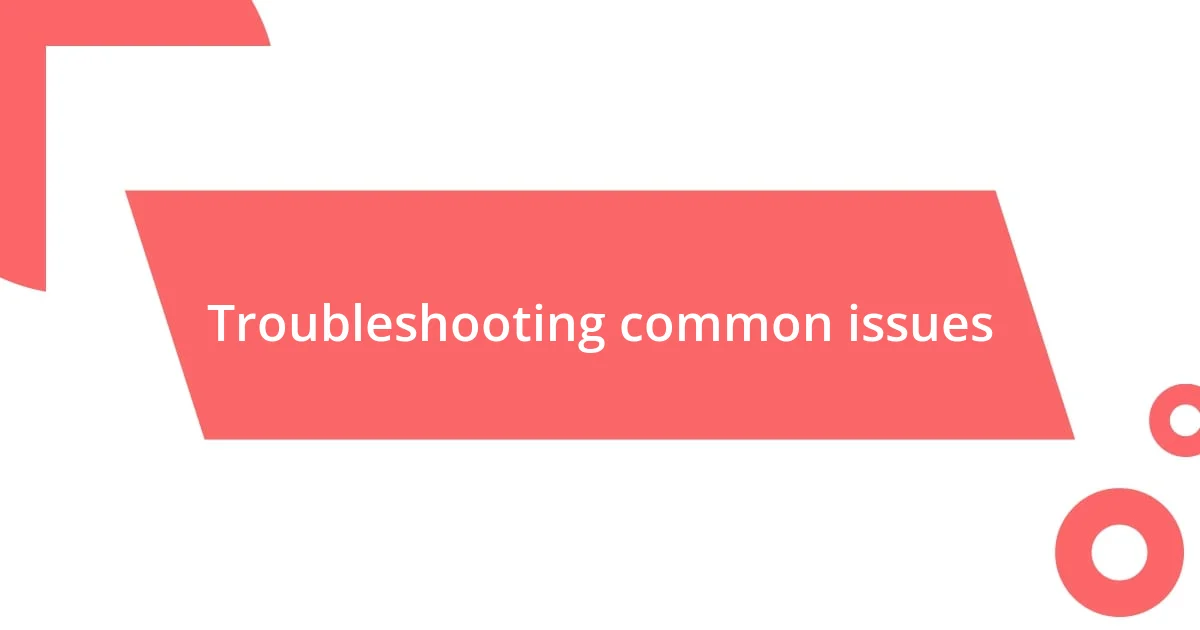
Troubleshooting common issues
When troubleshooting common issues with a cast iron skillet, one of the most frequently encountered problems is sticking food. I vividly recall the first time I attempted to fry an egg, only to watch it cling stubbornly to the surface. It felt disheartening, but I quickly learned that preheating my skillet properly, coupled with using enough oil, made all the difference. Have you ever experienced similar frustrations? Just remember, a well-preheated pan can create that perfect non-stick environment we all crave.
Another issue I’ve faced is uneven heating. There have been moments when one side of my skillet cooked beautifully while the other side left my food undercooked. I discovered that rotating the skillet occasionally while cooking helps distribute the heat more evenly. Sometimes, I would even switch positions on the burner. Have you tried this approach? Small adjustments like this can transform your cooking experience and ensure consistent results.
Lastly, a common fear involves scratching the seasoning. I can definitely relate to the anxiety of accidentally using the wrong utensils. Early on, I was too casual and used metal spatulas without thinking twice. It felt like each scrape chipped away a piece of my skillet’s character. Since then, I’ve turned to silicone or wooden utensils, which not only protect the seasoning but also provide a gentle touch. Do you have your go-to tools that safeguard your skillet? It’s all about fostering that special bond, ensuring your cast iron remains a cherished kitchen companion for years to come.
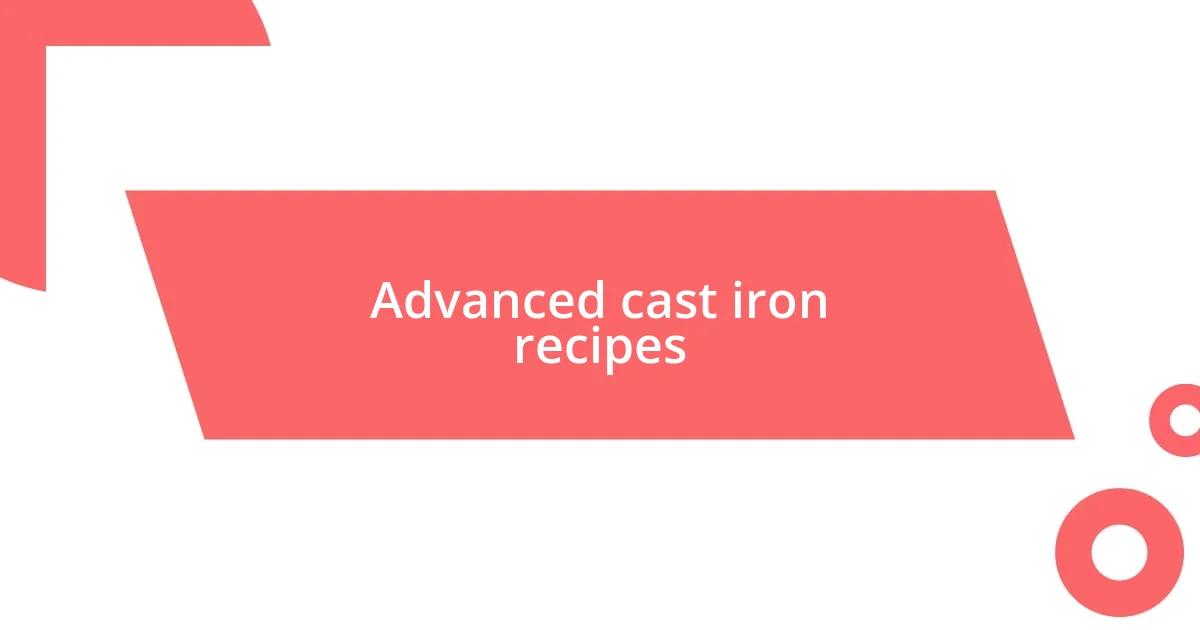
Advanced cast iron recipes
When it comes to advanced recipes, let me tell you about my newfound love for a perfectly seared steak in my cast iron skillet. I used to shy away from this dish, fearing it wouldn’t stand up to the heat. However, after a few attempts, I discovered that preheating the skillet and using a bit of high-smoke-point oil creates a beautiful crust that locks in those savory juices. There’s something incredibly satisfying about hearing that sizzle as I place the steak in the skillet—it feels like magic!
One evening, I decided to get fancy and made a frittata right in my cast iron. I mixed fresh vegetables, herbs, and cheese, then poured beaten eggs over the top. As it baked, the aroma filled my kitchen, and I couldn’t help but feel proud. This dish taught me the versatility of my skillet; it’s not just for frying, but for creating hearty meals that can impress even the guests. Have you ever experimented with breakfast dishes? I urge you to try it; the results might surprise you!
Then there’s my go-to recipe for cornbread, which, let me assure you, is a game-changer. I remember the first time I poured batter into that hot skillet and watched it rise in the oven. The edges turned crisp and golden, while the center remained wonderfully moist. Serving it straight from the skillet adds a rustic charm that few dishes can match. There’s something about that warm, buttery flavor that brings back fond memories of family gatherings. What special recipes have you made? The beauty of cooking with cast iron lies in its ability to transform simple ingredients into unforgettable meals.










